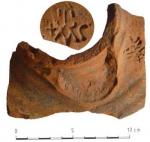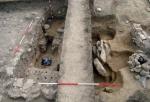Summary (English)
PLISKA (Pavel Georgiev – pavel_g@gbg.bg, Tihomir Tihov, Radoslav Vasilev) In Trench XX the dug out structure with a well faced with stones were explored. Sherds of the 10th – 11th centuries were found, including a sherd from an amphora with a stamp with the personal name: +TOMAC. A coin of Constantine X Doukas and Eudokia was discovered and it dated the filling of the dug out structure with earth not before the AD 1060s. House No. 21 had a stove and its walls were faced with wooden boards. Its western side adjoined the palisade. An earlier timber building was documented under the palisade and a follis of Nikephoros I Genikos and Staurikios was found there. The palisade and House No. 21 dated after AD 811. Baths No. 2 of the first half of the 9th century AD were discovered. The building was 60 sq. m in size and had three rooms. The entry room was an apodyterium with frigidarium. The second room had a niche for a tub and was a tepidarium with walls that were heated, judging from the tubuli. The third room was a caldarium with praefurnium. The furnace was on the northern wall of the baths. Sunken-floored Houses Nos. 19, 22 and 23 were explored, dug into the ruins of Baths No. 2. Christian Grave No. 15 belonging to a young girl was discovered above the debris of House No. 19. A later pit containing three Byzantine coins: one anonymous follis of the Class A2 and two anonymous folles of the Class C (AD 1042 – 1050) was dug into the debris of House No. 22. House No. 23 partly destroyed a cistern built of bricks and a water conduit. Four storage pits related to the houses were explored. One of the pits contained an anonymous follis of the Class A1 (AD 970 – 976) overstruck on a coin of Nikephoros II Phokas. The finds from the excavations included a lead seal of the AD 830s – 840s belonging to “Ioannes, Patrikios, Protospatharios and Imperial Oikistikos”.
- Pavel Georgiev - Shumen Branch of the Archaeological Institute and Museum
- Tihomir Tihov - Regional Museum of History – Shumen
- Radoslav Vasilev - Archaeological Institute with Museum
Director
Team
Research Body
- Archaeological Institute with Museum
- Regional Museum of History – Shumen
- Shumen Branch of the Archaeological Institute and Museum






![Download [PDF]](/excavation/skins/fasti/images/results/download_sml.png)

